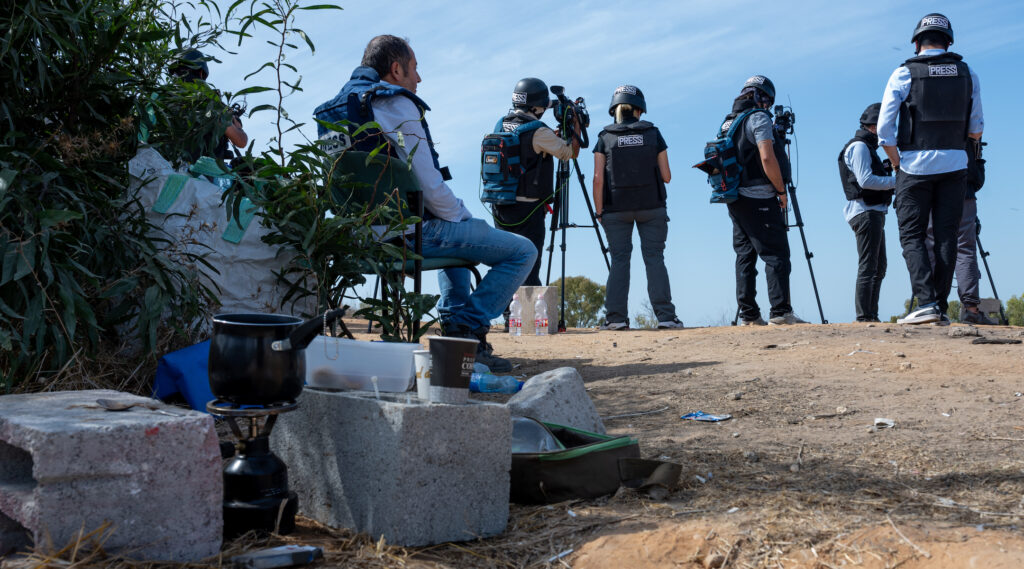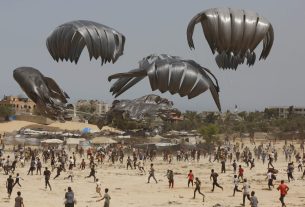((JEWISH REVIEW)) — International news outlets denied that photographers they hired had advance knowledge of Hamas’s Oct. 7 attack on Israel, after a report suggested without hard evidence that the journalists may have coordinated with the terror group ahead of the invasion.
But the Associated Press and CNN have said they will no longer work with one of the photographers named in the report, Hassan Eslaiah. The other publications named in the report are Reuters and The New York Times.
The report, by pro-Israel media watchdog Honest Reporting, said freelance photographers working with the four publications were at the scene in the early hours of the Hamas attack, saying their presence raised “ethical questions.”
It comes as dozens of journalists have been killed in the war, mostly in Gaza, and as reporters and photographers in the territory face scrutiny for their approach to the conflict. According to the Committee to Protect Journalists, 39 journalists have been killed since the start of the war, including 34 Palestinians, four Israelis and one Lebanese journalist. (Some have died in their homes and not while engaging in journalism.)
On Thursday, Sherif Mansour, the Committee to Protect Journalists’ Middle East and North Africa program coordinator, said in a statement that “journalists are civilians doing important work during times of crisis and must not be targeted by warring parties.”
But citing the Honest Reporting document, the Israeli Government Press Office said it “demands explanations” of the international outlets, adding that the “involvement of their photographers” in the attack “crosses every red line, professional and moral.” Israeli Communications Minister Shlomo Karhi wrote a letter to the news outlets, demanding they investigate possible collusion between the photographers and Hamas.
The report released on Wednesday, did not include concrete evidence of collusion. But it suggested the photographers knew ahead of time about the assault or “coordinated” with the attackers, since Hamas breached Israel’s border early on a Saturday morning when the journalists would likely not be working.
“Is it conceivable to assume that ‘journalists’ just happened to appear early in the morning at the border without prior coordination with the terrorists? Or were they part of the plan?” the report said, placing quotation marks around the word “journalists.”
“Even if they didn’t know the exact details of what was going to happen, once it unfolded did they not realize they were breaching a border?” the report added. “And if so, did they notify the news agencies?”
The four publications all denied that they coordinated with Hamas. Reuters said in a statement that it “categorically denies that it had prior knowledge of the attack or that we embedded journalists with Hamas.” AP said it “had no knowledge of the Oct. 7 attacks before they happened.” The New York Times called the allegations “untrue and outrageous.”
CNN told the Israeli publication Ynet it has not “found reason to doubt the journalistic accuracy of the work [Eslaiah] has done for us,” even as it cut ties with him.
The four photographers named in the report took pictures of a burning Israeli tank from which soldiers were killed or kidnapped, as well as attacks on Israeli homes and terrorists taking hostages and bodies back into Gaza.
HonestReporting, citing screenshots of deleted tweets, said Eslaiah posted footage of himself in front of a burning tank and photographed attacks on Kfar Aza, the scene of one of the worst massacres of the day. Eslaiah was not wearing a press vest or helmet to identify him as a member or the media, the report said.
Eslaiah, who works with CNN and AP, was also seen in an undated photograph with Hamas leader Yahya Sinwar that Honest Reporting shared after the report was released. Sinwar is kissing Eslaiah’s cheek in the image, suggesting that he was friendly with the terror group official in a way that crosses clear ethical lines in journalism.
Amit Segal, a prominent Israeli reporter, said Eslaiah appeared to hold a grenade while riding a motorcycle on the day of the attack in a video posted to Eslaiah’s Facebook page. His face is not clearly visible in the video.
The publications say they haven’t breached any journalistic ethics. Reuters said it had no prior relationship with the photographers before Oct. 7, though it did not elaborate on that, and said that their images were taken two hours after Hamas launched a rocket barrage against Israel. The terrorists breached the border shortly after the salvo.
AP said the first pictures it used had been taken more than an hour after the attack started.
The New York Times, which has worked with a different photographer named in the report, said, “It is reckless to make such allegations, putting our journalists on the ground in Israel and Gaza at risk.”
The Times drew fire from Israel supporters last month for rehiring a Gaza freelancer after finding out he made statements in support of Adolf Hitler. It also received criticism for initially reporting claims by Hamas that Israel bombed a hospital. Later assessments by Israel, the United States and a range of other governments and press outlets have found that a misfired Palestinian rocket was very likely the cause of the explosion.
The Times later said its early coverage of the incident “relied too heavily on claims by Hamas, and did not make clear that those claims could not immediately be verified,” said an Oct. 23 editor’s note. “The report left readers with an incorrect impression about what was known and how credible the account was.”
Israel has drawn criticism for not adequately protecting the lives of reporters covering the region’s violence. But on Thursday, Benny Gantz, a member of Israel’s emergency war cabinet, wrote on social media that Israel would not make allowances for journalists who coordinated with Hamas.
“Journalists found to have known about the massacre, and still chose to stand as idle bystanders while children were slaughtered — are no different than terrorists and should be treated as such,” he wrote.




